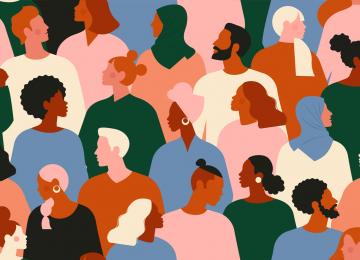
Equity, diversity, and inclusion (EDI) work is and has always been challenging because it invites us to self-reflect as individuals, and as organizations.

Equity, diversity, and inclusion (EDI) work is and has always been challenging because it invites us to self-reflect as individuals, and as organizations. It requires the exploration and acknowledgement of inequities and overcoming the defensiveness that comes from conversations on power and privilege.
While such conversations and reflection can be challenging, they are also important if change is to succeed. In light of the recent Black Lives Matter protests that have taken place around the world and the focus these have placed on diversity and inclusions topics, Engineers Canada reached out to our colleagues at the Canadian engineering regulators who are working on improving EDI in the profession. In this first article of a three-part series, they share their thoughts on the importance of EDI work in the engineering profession, and what makes it a pressing issue.
Engineers Canada: Why do you believe EDI work is important to the engineering profession?
 Marcie Cochrane, 30 by 30 Coordinator, Engineers and Geoscientists BC: The profession of engineering is one that is based on public safety and improvement of the world we live in. Engineering is connected to the lives of every person, every day: from the infrastructure we rely on, the products we use, and the systems we benefit from. Given this diversity of users and needs, it is important that the profession of engineering reflect this diversity so that the solutions delivered meet the varying needs and interests of the public. Design teams that have diversity are more likely to develop innovative solutions that meet the needs of a more diverse range of end users.
Marcie Cochrane, 30 by 30 Coordinator, Engineers and Geoscientists BC: The profession of engineering is one that is based on public safety and improvement of the world we live in. Engineering is connected to the lives of every person, every day: from the infrastructure we rely on, the products we use, and the systems we benefit from. Given this diversity of users and needs, it is important that the profession of engineering reflect this diversity so that the solutions delivered meet the varying needs and interests of the public. Design teams that have diversity are more likely to develop innovative solutions that meet the needs of a more diverse range of end users.
 Lisa Stepnuk, Director, Equity and Representation, Engineers Geoscientists Manitoba: Engineering work affects every aspect of our lives, communities, and environments: food security, potable water, sanitation, energy production and distribution, housing and construction, transportation, safety, environment and wildlife, communications, data processing, health care technologies for diagnostics, processes and treatment, policing, surveillance and more. That means that engineers hold a lot of societal power.
Lisa Stepnuk, Director, Equity and Representation, Engineers Geoscientists Manitoba: Engineering work affects every aspect of our lives, communities, and environments: food security, potable water, sanitation, energy production and distribution, housing and construction, transportation, safety, environment and wildlife, communications, data processing, health care technologies for diagnostics, processes and treatment, policing, surveillance and more. That means that engineers hold a lot of societal power.
We can see in Section 13 of the Calls for Justice of the National Inquiry into Missing and Murdered Indigenous Womxn, Girls, and Two Spirit that the physical, environmental and economic safety and well-being of Indigenous women is not yet understood and prioritised as part of all extraction and development projects. We can see from the research on facial recognition technologies that racial and gender bias can be programmed into the software if the right questions and testing aren’t diligently undertaken, having serious consequences for women, gender non-conforming, and dark-skinned people vis-à-vis policing and automated vehicles. Many new buildings still don’t have washrooms that are safe for non-binary, transgender, and gender non-conforming people. Car safety ratings for bodies other than “the average American male” were only mandated this past decade. What are the ethical implications of putting a seal to these projects, products and designs? Who do we design and problem solve for? Whose voices, ideas, and concerns are heard and acted upon? Whose are ignored? What solutions aren’t even imagined or considered? Who is harmed? Who is sacrificed? What opportunities for justice are missed?
 Kathy Baig, President, Ordre des Ingénieurs du Québec (OIQ): For me, equity, diversity and inclusion are fundamental because I believe that everyone should have an equal chance, regardless of their origin, sex or affiliation. Greater diversity makes it possible to attract and retain top talent, generate new ideas and encourage innovation. It makes organizations, including those active in engineering, more competitive and efficient.
Kathy Baig, President, Ordre des Ingénieurs du Québec (OIQ): For me, equity, diversity and inclusion are fundamental because I believe that everyone should have an equal chance, regardless of their origin, sex or affiliation. Greater diversity makes it possible to attract and retain top talent, generate new ideas and encourage innovation. It makes organizations, including those active in engineering, more competitive and efficient.
Even though we welcome and assist over 3,000 new members every year at the OIQ, Quebec is grappling with a shortage of skilled labour. Another factor affecting engineering is that 35 per cent of our members are over 50 years of age. This makes recruitment and the next generation of engineers a priority issue for our profession. We want to drive recruitment by not only drawing more women into engineering, but also by making it easier for immigrants with engineering training to enter the job market. To do this, professional experience and other considerations need to be recognized, not just degrees.
 Mohamed El Daly, Director, Outreach and Product Services, APEGA: We believe that EDI is important to every profession—but especially in traditionally white male dominated fields like engineering—because women, and other under-represented groups, face systemic and interpersonal barriers to enter and thrive in the professions. This is detrimental to the profession, organizations, and individuals in the profession and society. In addition, there is a business case to be made in favor of diversity and inclusion—when organizations have a diverse workforce that feel engaged and welcomed to be their authentic selves in the workplace—creativity, innovation, and profits increase, which alone should motivate leaders to adopt more inclusive practices.
Mohamed El Daly, Director, Outreach and Product Services, APEGA: We believe that EDI is important to every profession—but especially in traditionally white male dominated fields like engineering—because women, and other under-represented groups, face systemic and interpersonal barriers to enter and thrive in the professions. This is detrimental to the profession, organizations, and individuals in the profession and society. In addition, there is a business case to be made in favor of diversity and inclusion—when organizations have a diverse workforce that feel engaged and welcomed to be their authentic selves in the workplace—creativity, innovation, and profits increase, which alone should motivate leaders to adopt more inclusive practices.
 Laura Douglass, EIT, Diversity & Inclusion Coordinator, APEGNB: In order for the engineering profession to be self-sustaining, I believe it requires diverse perspectives and continuous innovation. We have seen examples of spectacular innovations that only for a small subset of people but exclude, or even endanger other groups. Lisa Stepnuk cited some examples of this in her response. This should not be the case, especially with the complexity of the global workforce and the level of accessibility to talented people from all walks of life. Equity, diversity, and inclusion are corner stones to creating the change needed in our profession.
Laura Douglass, EIT, Diversity & Inclusion Coordinator, APEGNB: In order for the engineering profession to be self-sustaining, I believe it requires diverse perspectives and continuous innovation. We have seen examples of spectacular innovations that only for a small subset of people but exclude, or even endanger other groups. Lisa Stepnuk cited some examples of this in her response. This should not be the case, especially with the complexity of the global workforce and the level of accessibility to talented people from all walks of life. Equity, diversity, and inclusion are corner stones to creating the change needed in our profession.
Engineers Canada: What makes EDI in engineering a pressing issue? What’s the urgency? Why is it important to talk about EDI in engineering right now?
Douglass: We can see the world changing in front of our eyes, in 2020 more so than ever. I think that if engineering companies and institutions don’t have a plan and an EDI strategy, they are falling behind, and within five years, they will see the impact of sitting on the sidelines. These diverse perspectives, not just in entry-level roles or the student population, but within upper leadership, management and academic faculty are key to innovation and creativity required to move organizations ahead.
Cochrane: We are at a point in time where we are examining the inequities and systemic barriers in our society: collectively working to learn, understand, and improve. We know that the profession of engineering has room for improvement—we have metrics on gender diversity that demonstrate this. Less available is data for other diversity metrics within the profession, but we know that our profession does not yet fully reflect the diversity of the general population. Therefore, it is vital to talk about EDI in engineering right now, while these important conversations are occurring. To see change and promote diversity within the profession we must be willing to engage in conversations that can be difficult and uncomfortable. There is a growing expectation for organizations to engage in these conversations and to take action, and the risk in not talking about EDI in engineering right now is the potential to lose employees, clients, and public confidence.
Baig: Due to the pandemic, the media talked very little about EDI, which is somewhat understandable. However, we must not lose sight of the related issues.
For example, the OIQ is encouraging diversity by participating in Engineers Canada’s nationwide 30 by 30 initiative, which aims to ensure that women make up 30 per cent of new engineers by 2030. According to some studies, 30 per cent is the “magic” number because once 30 per cent has been reached, the minority group succeeds in being heard, getting its needs met and asserting its opinions.
In addition, women and professionals who have immigrated are still underrepresented on boards of directors and have a hard time breaking the glass ceiling to reach senior executive positions. Yet, engineering is a promising profession for women and offers wonderful career prospects.
El Daly: It is important to talk about anywhere that there remains an imbalance for full and authentic participation by all. Engineering, like many other professions, is being forced to make some tough choices right now—we should not fall back on historic structures of discrimination, and only think about equity when it is convenient to do so, rather, we should see this as an opportunity to re-create an equitable foundation for the profession.
Check back in the next edition of Engineering Matters for the second article in this three-part series, in which Cochrane, Stepnuk, Douglass, Baig, and El Daly discuss the ways in which the COVID-19 pandemic has impacted EDI in the engineering profession.


